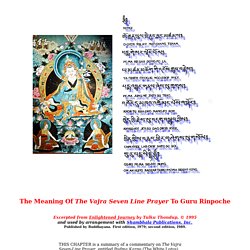

Info.stiltij.nl/publiek/meditatie/leraren/_historisch/shantideva-bodhicaryavatara-wallace.pdf. The Tibetan Book of the Dead: The Art of Dying. In addition to constituting the most notable meditative practices of the Kagyu-pa order, the tradition of the Six Yogas of Naropa was adopted also by the powerful Geluk-pa or "System of Virtue Sect" (dge lugs pa), which was founded by the brilliant philosopher-saint Dzongka-pa (Tsong kha pa, 1357-1419), and which eventually became the institutional seat of the successive Dalai Lamas.

Dzongka-pa's treatise, A Book of Three Inspirations, is regarded as one of the finest works on the subject of the Six Yogas, and over the past five hundred years has served as a standard for the majority of works that later followed. In A Book of Three Inspirations, Dzongka-pa discusses the practices of all Six Doctrines with extraordinary precision and depth, quoting from a wealth of Indian and Tibetan sources as well as drawing upon his own profound inner experience.
The Berzin Archives – The Buddhist Archives of Dr. Alexander Berzin – Home Page. Introduction to the Kalachakra Tantra. Nyingma The Rinchen Terdzod. A selection of articles related to nyingma the rinchen terdzod.

Original articles from our library related to the Nyingma The Rinchen Terdzod. See Table of Contents for further available material (downloadable resources) on Nyingma The Rinchen Terdzod. The Aeonic Perspective of the Enochian Temples The initiatory system of the Enochian Temples divides the path of initiation into four major stages, distinguished primarily by the types and sources of the influences they are sensitive to. Briefly, these stages are: 1. Magick >> Enochian Bringing it Down to Earth: A Fractal Approach 'Clouds are not spheres, mountains are not cones, coastlines are not circles, and bark is not smooth, nor does lightning travel in a straight line.' Mystic Sciences >> Astrology >> Modern Science Mother Of The Gods And The Father Of The Gael There is no surviving, or as yet translated, Creation story within Irish mythology.
Deities & Heros >> Celtic, Welsh, Irish & Brittish Mystic Sciences >> Necromantic Studies. Commentary on the Seven Line Prayer to Guru Rinpoche. THIS CHAPTER is a summary of a commentary on The Vajra Seven-Line Prayer, entitled Padma Karpo (The White Lotus), written by Mipham Namgyal (1846-1912), a celebrated scholar of the Nyingma Buddhist tradition of Tibet.

The original Tibetan text of Mipham's commentary is very profound and difficult to understand or to translate, and I have summarized the basic points of his text in this chapter. The Vajra Seven-Line Prayer is the most sacred and important prayer in the Nyingma tradition. This short prayer contains the outer, inner, and innermost teachings of the esoteric trainings of Buddhism. By practicing The Vajra Seven-Line Prayer according to any one of these trainings, the result of that particular training will be attained. In this summary there are five levels of interpretation. In Tibet, the Nyingmas recite The Vajra Seven-Line Prayer to Guru Rinpoche three times before reciting any other prayers, doing any meditation, or performing any ceremony.
Root Meaning Line 1. Line 2.
Www.kunpal.com/bca1comm.pdf.